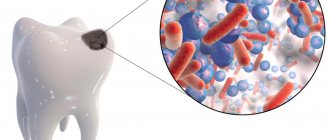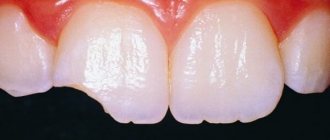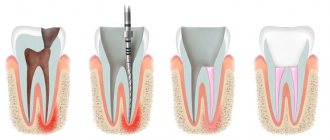1917
The materials from which dentures are made are very important from the point of view of their impact on the dental cavity and on the body as a whole.
Up to 35% of patients with metal dentures experience problems related to their material.
Difficulties are also created by some amalgam fillings, implants, orthodontic devices, and inlays. The name of the main one of these problems is “galvanism”.
Galvanic syndrome in the mouth - why it appears and how to deal with it
Article navigation
- What is galvanic syndrome
- Causes
- Classification and symptoms
- Diagnostics
- Treatment
- Complications without treatment
- Prevention
- Cost of treatment
- User Questions
Question for a specialist
Dental prosthetics is sometimes complicated by some rather unpleasant conditions - and a person may not even suspect that the problem is in the prosthesis. One of these processes is galvanism in the oral cavity, which is also called “galvanosis” or “galvanic syndrome”. Next, we will tell you why it occurs, what symptoms it is accompanied by, how it is treated - and whether it is worth doing anything about it at all.
Treatment
Galvanism treatment involves removing metal structures from the mouth, after which all unpleasant sensations disappear on their own. Positive dynamics are not always noticeable immediately, and the recovery process sometimes drags on for several months. In parallel, additional symptomatic therapy can be carried out aimed at eliminating immune disorders and correcting infectious and precancerous diseases.
After the complete disappearance of all clinical manifestations of this pathology, the treating dentist decides on the issue of repeat prosthetics. In this case, either one of the prostheses, which is made of the same metal, is replaced, or all elements that are made of the same material must be replaced.
With galvanosis, an excellent solution to the problem can be ceramic prostheses, which do not contain metal parts and do not conduct electricity, but at the same time have excellent properties, such as strength and high aesthetics.
What is galvanic syndrome
Galvanic syndrome is encountered by people who have metal prostheses made of dissimilar metals installed on their teeth (fillings, crowns, inlays, implants). Oxides of certain metals, which have different electrochemical activity and come into contact with a liquid electrolyte medium (in this case, saliva), provoke an increase in galvanic currents in the oral fluid. In a simplified version, electrical impulses appear between prostheses made of different metals due to their chemical properties. This process is called galvanism.
And the pathology called “galvanosis” becomes a consequence of galvanism. That is, galvanosis is already a diagnosis. With galvanosis, the patient notices pathological symptoms - for example, a metallic taste in the mouth (more on this below), and if left untreated, very serious consequences for the entire body are possible. By the way, there are quite a lot of patients who, to one degree or another, have encountered galvanic syndrome in the mouth - from 15% to 35% of all cases of prosthetics.
Complex on 4 OSSTEM implants with delayed loading - 150,000 rubles.
Complex implantation Osstem (South Korea) with delayed loading after 4-6 months.
Doctor's work guarantee - up to 5 years (under an agreement on the provision of medical services) Call now or order a call
Opening hours: 24 hours a day - seven days a week
Interestingly, the phenomenon of galvanism in a living organism was first discovered, but not studied in detail, by the Italian scientist Luigi Galvani, after whom the process was named. Although in fact, the true meaning of galvanic currents (including in the body) was revealed by Galvani’s student Alessandro Volta. Moreover, Volta went further than his teacher and made many discoveries in the field of electricity, and also developed the first battery, the operating principle of which was based on chemical processes.
Concept and general idea
More than 20 metals are used as materials for orthopedic and orthodontic devices - in pure form or in the form of alloys. Among them are gold, titanium, alloys of iron, nickel, molybdenum and others.
Some of these metals form galvanic pairs with each other - two conductors exchanging electrical charges with each other , as a result of which electrochemical corrosion of one of them occurs, and various elements are released into the saliva, violating its neutrality in relation to the tissues of the oral cavity.
The most active microcurrents are created by bimetallic pairs:
- gold-amalgam;
- amalgam-steel-solder;
- steel-steel-solder.
Reference. Often the words “galvanism” and “galvanosis” are used as synonyms, although in fact they mean different phenomena.
"Galvanism" as applied to dentistry is the induction of electric current in the oral cavity due to an electrochemical reaction occurring between the metals from which orthodontic or orthopedic devices are made. “Galvanosis” is a disease caused by galvanism.
Causes of galvanic syndrome
The main reason for galvanism in the mouth (and not only) is the interaction of metals with different potentials. Today, about 20 metals and their alloys are used in dentistry - these are nickel, cobalt, chromium, iron, copper, zinc, titanium, gold, platinum, mercury and others. And it is not always possible to carry out prosthetics using the same metal that is already in the patient’s mouth. For example, in a situation where the previous prosthetics1 was a long time ago and now the person no longer remembers what exactly the prosthesis is made of, and the doctor cannot determine “by eye” all the components of the alloy.
An active galvanic process can occur in the following situations:
- crowns, inlays or fillings based on metals are installed in the mouth and these metals are different: for example, a reaction will not occur between gold and gold, but galvanism is quite possible between an amalgam filling and a steel crown. It is also not necessary that the dentures be made only of metal; galvanism can occur on metal-ceramics (crowns), which are based on different metals,
- there are scratches or corrosion on metal prostheses,
- dentures are manufactured or repaired by soldering,
- For prosthetics and implantation, low-quality raw materials with undesirable impurities are used: of course, the blame here falls on unscrupulous suppliers. Therefore, the clinic should take a responsible approach to the choice of materials,
- wearing orthodontic devices made of various metals: these can be braces or plates. Galvanism can also occur between a splinting retainer (worn after braces) and a metal crown in the mouth,
- if the patient has allergic reactions, immunity is reduced.
BEST REMOVABLE DENTURE - 20,000 rub.
All manipulations for the manufacture, installation and fitting of the prosthesis, including impressions, are included.
Save RUB 10,000! >> Call now or request a call
Opening hours: 24 hours a day - seven days a week
An increase in galvanic syndrome can occur when the properties of saliva change (when its acidity increases) due to stomatitis, periodontitis or general diseases, or if a person regularly consumes acidic foods.
Classification and symptoms
There are two forms of galvanosis - typical (in which a person experiences several pronounced local symptoms at once) and atypical (when symptoms most often occur singly and have a “blurred picture”). Moreover, signs of pathology usually do not appear immediately, but several weeks or months after prosthetics. Local signs of galvanism and symptoms of galvanosis are presented below:
- a sore taste in the mouth (sour taste) and/or a metallic, salty taste,
- itching and burning of the tongue or gums,
- changes in taste sensations: for example, if you eat something sweet, you may taste bitterness or acidity,
- changes in the volume and composition of saliva: patients often notice dry mouth, viscosity of saliva or foaming,
- a sensation of electricity “flowing” across the teeth, tongue, gums or palate,
- pathological conditions of the mucous membranes in the mouth: numbness, redness, swelling, teeth marks on the tongue,
- increased sensitivity of the gums and tongue,
- darkening of dentures.
If you ignore the problem and do not treat it, general symptoms will join the local symptoms. For example, a person may notice that his hearing is impaired, anxiety or headaches appear, sleep deteriorates, appetite disappears, fatigue increases, and cardiospasm occurs. By the way, these are the signs that may indicate an atypical form of galvanosis if there were no local symptoms. This state of affairs often confuses a person - after all, it is difficult to associate the problems that arise specifically with prosthetics. Therefore, for diagnosis, you must first visit your orthopedic dentist.
“Over the years of going to dentists, I have been given several dentures with metal. These included cobalt crowns, 1 inlay, and even 3 implants. After the last crown was installed, a burning sensation in my mouth began. At first I didn’t pay attention, but then I went to the dentist. They told me that everything would pass, that it was all my idea. But when I went to a more advanced clinic and underwent examination, they discovered galvanism. I had to remove all the metal from my mouth one by one. But the taste of electricity and dryness remained for several months, not very pleasant.” Anna, review from forum.stom.ru
Signs
Symptoms of the pathology are largely individual in nature - depending on the composition of saliva and the characteristics of the immune system of a particular patient.
The general and dental condition of the patient also influences the symptoms - the presence of foci of inflammation in the oral cavity, periodontal status, psycho-emotional state, hormonal levels.
From the point of view of severity, two forms of pathology are distinguished - typical and atypical. The first is characterized by pronounced symptoms, which greatly facilitates the diagnosis of the disease.
In the atypical form, the pathology is mostly asymptomatic, only sometimes signs appear that allow us to talk about the nature of the disease.
The first manifestations usually appear 1-2 months after orthopedic treatment:
- Burning sensation in the mucous membranes and tongue (most often on the tip or sides). The tongue is a pronounced reflexogenic zone, so it is one of the first to react.
- The taste of metal, salt, acid, which does not disappear after brushing your teeth and eating. H-ions are responsible for this taste, the body’s reaction to the presence of which with a feeling of sourness has long been known.
- Bitterness in the mouth.
- Change or complete loss of taste. In particular, sweet things can be perceived as bitter, or the combination of sweetness and bitterness can create a feeling of saltiness. Sometimes the patient is completely deprived of the sense of taste.
- Changes in salivation, often dry mouth, less often hypersalivation.
- Itching and/or pain in the gums.
- Exacerbation of chronic stomatitis and periodontitis.
The appearance of the mucous membrane is most often unchanged. Less commonly noted:
- hyperemia;
- swelling (usually in areas adjacent to metal structures);
- ulcers and erosions.
Systemic manifestations:
- deterioration of neurological status (general weakness, cancerophobia (fear of getting cancer), irritability, nervousness, headache).
- dysfunction of the central nervous system , manifested, in particular, by dry mouth.
How effective is laser treatment for wedge-shaped dental defects, and how is the procedure performed?
Come here if you are interested in what tablets you can take for toothache during pregnancy.
At this address https://zubovv.ru/lechenie/zubyi/kak-vyiglyadyat-tetratsiklinovyie.html find out whether tetracycline teeth can be whitened.
How is diagnostics carried out?
Diagnosis of galvanosis may include several different examinations and tests, because in addition to identifying the provoking factor (galvanism), it is necessary to exclude allergies and neurological disorders. First, the dentist conducts a survey of the patient, a visual examination of the oral cavity and installed metal prostheses (to identify areas of corrosion, fracture of soldered areas).
Using measuring instruments (microammeters, potentiometers, millivoltmeters), the main indicators are determined. Thus, the strength of the galvanic current should be up to 5-6 μA, the electrical conductivity of saliva is normally less than 5-6 μS, and the potential difference should be no more than 60 mV.
To complete the diagnosis and exclude pathologies with similar symptoms, you can consult a neurologist, cardiologist, gastroenterologist, ENT specialist and other doctors. Also in a number of situations, tests of saliva (chemical spectral study, pH determination), blood, and urine are prescribed.
Diagnostics
Diagnostics of galvanosis consists of measuring potential difference indicators, which are carried out according to a specific algorithm, which allows us to identify all possible deviations from physiological values and carry out a clear differential diagnosis with other pathological conditions (allergy to metals, metabolic disorders and electrolyte composition of saliva).
- The potential difference is measured using special multimeters or voltmeters.
- All measurements are carried out repeatedly, determining the difference between various objects located in the mouth: soft tissues, teeth, metal structures.
- The results obtained are assessed based on maximum indicators.
- If a difference in potentials is detected that exceeds the physiological value, then the study is repeated again, but only before the test the person rinses his mouth with distilled water.
Additionally, patients with suspected galvanosis are prescribed:
- measurement of saliva acidity;
- biochemical examination of blood and saliva;
- skin tests for sensitivity to metals that are part of dentures;
- general clinical examinations of blood and urine.
Treatment of galvanosis in the oral cavity
Before treating galvanosis in the mouth, the dentist identifies the cause of the pathology and draws up a treatment plan, since much depends on the indications and symptoms. In simple cases, it is enough to replace the prosthesis (by choosing a different metal, choosing acrylic or pure ceramics). And in difficult situations, when pathologies caused by galvanism have occurred, treatment is supplemented with applications and rinses with medicinal substances to relieve inflammation and tissue regeneration. They may also prescribe antibacterial drugs, immunomodulators, and less commonly, surgical intervention (for example, to remove a dental implant).
During galvanosis therapy, oral cavity sanitation is carried out - treatment of caries and pulpitis, stomatitis, restoration of the health of the gums, periodontium (the ligamentous apparatus of the tooth). Treatment of the consequences of the pathology usually takes about 6 months. Sometimes it is difficult to relieve the symptoms of galvanosis, or rather, it is difficult for the patient himself to distinguish its true symptoms from phantom ones. It seems that in the mouth, for example, the process of galvanism is still going on - a metallic taste supposedly remains, although in reality this is no longer the case. Therefore, after consultation with a neurologist or psychotherapist, they may additionally prescribe sedatives and relaxation courses.
Reviews
If you have encountered such a phenomenon as galvanism, please share it with visitors to our site. How did you feel and how did you manage to get rid of this problem?
Your comment at the bottom of this page can be of practical benefit to people who are encountering pathology for the first time.
If you find an error, please select a piece of text and press Ctrl+Enter.
Tags: teeth, oral cavity
Did you like the article? stay tuned
No comments yet
Complications without treatment
Galvanosis must be eliminated and symptomatic therapy carried out, otherwise there is a risk of the following complications:
- stomatitis, gingivitis, papillitis: bacterial or viral lesions of the mucous membranes,
- oral leukoplakia,
- the occurrence of benign and malignant neoplasms in the mouth,
- psychoemotional disorders against a background of constant discomfort, distortion of taste sensations,
- deterioration of the general condition of the body: problems with the gastrointestinal tract, cardiovascular and respiratory systems,
- weakening of facial muscles, premature appearance of wrinkles.
Complications
The long-term existence of galvanism in the oral cavity not only causes discomfort to a person, but can also stimulate the degeneration of normal healthy cells into malignant ones with the development of oncological pathology, which is very difficult to treat. First, background diseases or precancer (for example, leukoplakia) arise, and then, due to lack of therapy and repeated exposure to current, cancer develops.
A decrease in local immunity provokes inflammatory diseases of the oral cavity: stomatitis, gingivitis, papillitis.
Prevention of galvanic syndrome
In order to prevent galvanosis, you should carefully choose a doctor and clinic where you are planning prosthetics or implantation. It is also advisable to know what the already installed prosthetic structures are made of, and to communicate such nuances during subsequent prosthetics with another specialist.
The basic rule is to use the same metal for prosthetics. It is optimal to choose chemically inert metals - alloys of gold, platinum, palladium or titanium. And the metal prostheses or inclusions themselves must be manufactured using modern methods - casting or milling using CAD/CAM technology. Before prosthetics, it would be useful to take allergy tests to identify individual intolerance to metal - and if an allergy is detected, then it is better to choose ceramic, zirconium dioxide, acrylic non-monomer prostheses.
Don't know what type of prosthetics to choose?
We will help in the selection, advise where to read more information and compare types of prosthetics.
Consultation with an orthopedic doctor in Moscow clinics is free! Call now or request a call
Working hours: from 9:00 to 21:00 - seven days a week
Cost of pathology treatment
How much it costs to cure galvanosis will depend on the amount of work. For example, the cost of tests starts from 2000 rubles, ceramic or metal-free crowns - from 12 thousand, acrylic dentures - from 25 thousand, and a high-quality implant with a crown can be installed for 35 thousand rubles.
User Questions
QUESTION: Hello, I would like to ask you if a new metal-ceramic crown can cause a feeling of electric discharge in the mouth? I finished prosthetics a week ago, and now something strange has started to happen. Irina
ANSWER: If you already have metal dentures (except for a new crown), then your symptoms may well be signs of galvanosis. Moreover, it can even be provoked by a zinc metal pin in the root canal, left after treatment of pulpitis. Therefore, it is better to immediately contact your orthopedic dentist and undergo an examination, since galvanic syndrome will not go away on its own. We need to find the cause and eliminate it.
- Wulfes H. Modern prosthetic technologies, 2002.
Author: Chernov A. R. (Thank you for your help in writing the article and the information provided)










